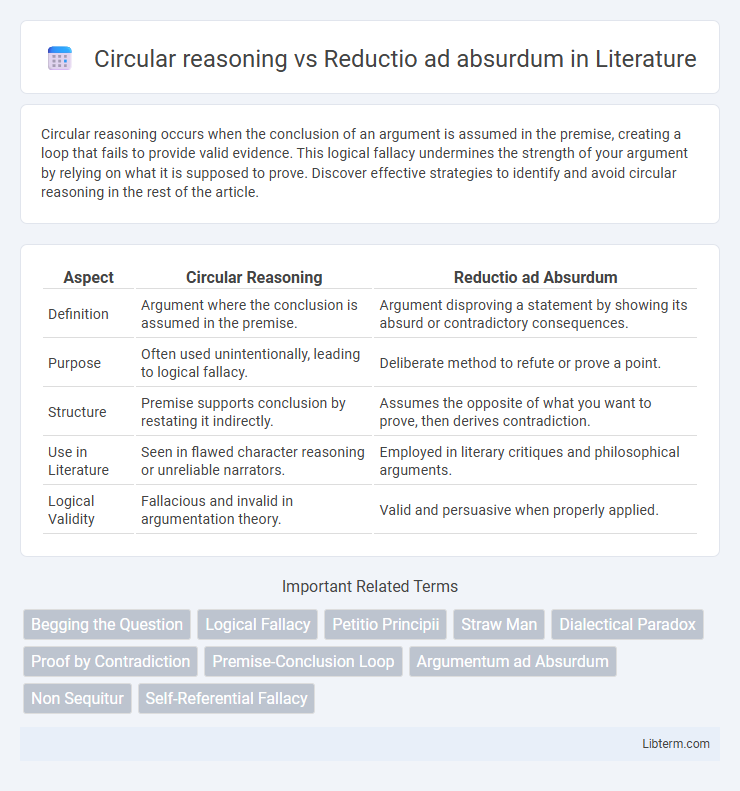Circular reasoning occurs when the conclusion of an argument is assumed in the premise, creating a loop that fails to provide valid evidence. This logical fallacy undermines the strength of your argument by relying on what it is supposed to prove. Discover effective strategies to identify and avoid circular reasoning in the rest of the article.
Table of Comparison
| Aspect | Circular Reasoning | Reductio ad Absurdum |
|---|---|---|
| Definition | Argument where the conclusion is assumed in the premise. | Argument disproving a statement by showing its absurd or contradictory consequences. |
| Purpose | Often used unintentionally, leading to logical fallacy. | Deliberate method to refute or prove a point. |
| Structure | Premise supports conclusion by restating it indirectly. | Assumes the opposite of what you want to prove, then derives contradiction. |
| Use in Literature | Seen in flawed character reasoning or unreliable narrators. | Employed in literary critiques and philosophical arguments. |
| Logical Validity | Fallacious and invalid in argumentation theory. | Valid and persuasive when properly applied. |
Introduction to Circular Reasoning and Reductio ad Absurdum
Circular reasoning occurs when the conclusion of an argument is assumed in its premises, creating a logical loop that fails to provide independent support for the claim. Reductio ad absurdum involves disproving a proposition by showing that its logical consequences lead to a contradiction or an absurd outcome, thereby demonstrating the proposition's falsity. Both techniques are critical in logical analysis, with circular reasoning representing a fallacy and reductio ad absurdum serving as a powerful method for valid argumentation.
Defining Circular Reasoning: Meaning and Examples
Circular reasoning is a logical fallacy where the conclusion is included in the premise, creating a loop that lacks independent support. For example, stating "I am trustworthy because I always tell the truth" assumes the truthfulness of the claim without external evidence. This contrasts with reductio ad absurdum, which disproves a statement by showing that its logical conclusion leads to an absurd or contradictory result.
Defining Reductio ad Absurdum: Meaning and Applications
Reductio ad absurdum is a logical technique that disproves a proposition by demonstrating that its logical conclusion leads to a contradiction or an absurd outcome. It is widely applied in mathematics and philosophy to challenge assumptions by showing that their acceptance results in untenable or false scenarios. Unlike circular reasoning, which assumes what it tries to prove, reductio ad absurdum rigorously tests validity by exposing inconsistencies within an argument's implications.
Key Differences Between Circular Reasoning and Reductio ad Absurdum
Circular reasoning involves using the conclusion as a premise, creating a logical loop without providing new evidence, whereas reductio ad absurdum disproves a claim by showing that its logical consequence leads to an absurd or contradictory outcome. Circular reasoning fails to advance an argument, whereas reductio ad absurdum strengthens an argument by demonstrating impossibility or contradiction. Key differences include that circular reasoning is a logical fallacy, and reductio ad absurdum is a valid method of proof in formal logic.
Logical Structures: Circular Reasoning vs. Reductio ad Absurdum
Circular reasoning involves a logical structure where the conclusion is assumed in the premises, creating a loop that fails to provide independent support for the argument. Reductio ad absurdum employs a method of indirect proof by assuming the negation of a statement and demonstrating that this assumption leads to a contradiction or absurdity, thereby validating the original statement. Unlike circular reasoning, reductio ad absurdum effectively challenges an argument by exposing inconsistency rather than presupposing the conclusion.
Common Contexts of Use for Each Argument Type
Circular reasoning frequently appears in flawed debates or misleading advertising where a premise is restated as a conclusion without independent support. Reductio ad absurdum commonly features in mathematical proofs and logical arguments, aiming to demonstrate the falsehood of a statement by deriving a contradiction or absurd outcome from its assumption. In philosophy and critical thinking, reductio ad absurdum is preferred for exposing flaws, while circular reasoning often signals weak or invalid argumentation.
Impact on Persuasion and Critical Thinking
Circular reasoning undermines persuasion by relying on a conclusion that is assumed within its premises, leading to weak arguments that fail to convince critical thinkers. In contrast, reductio ad absurdum strengthens critical thinking and persuasion by demonstrating that an opponent's argument leads to logical contradictions, compelling reevaluation of the original claim. Effective use of reductio ad absurdum fosters deeper analysis and intellectual rigor, while circular reasoning tends to stifle meaningful dialogue and consensus.
Circular Reasoning in Everyday Arguments
Circular reasoning occurs when the conclusion of an argument is assumed in its premises, creating a logical loop that fails to provide independent support for the claim. This fallacy frequently appears in everyday arguments, such as when someone insists a product is the best simply because it is popular, without offering objective evidence. Recognizing circular reasoning helps improve critical thinking by ensuring claims are supported by valid, non-redundant evidence rather than restated assumptions.
Reductio ad Absurdum in Philosophical and Mathematical Discourse
Reductio ad absurdum is a critical method in philosophical and mathematical discourse that disproves a statement by demonstrating that its logical consequences lead to a contradiction or an absurdity. Unlike circular reasoning, which unjustifiably assumes what it aims to prove, reductio ad absurdum rigorously tests assumptions by deriving an impossibility, thereby validating the negation of the original hypothesis. This technique is fundamental in proofs by contradiction and is extensively employed in logic, set theory, and philosophical argumentation to establish truth through refutation of falsehoods.
Avoiding Logical Fallacies in Rational Debates
Circular reasoning involves using a conclusion as a premise, creating a logical loop that fails to provide valid evidence, while reductio ad absurdum disproves a statement by demonstrating its logical absurdity or contradiction. Avoiding logical fallacies in rational debates requires recognizing and eliminating circular reasoning to maintain argument integrity, instead employing techniques like reductio ad absurdum effectively to challenge flawed assertions. Mastering these distinctions enhances critical thinking and ensures arguments are both sound and persuasive.
Circular reasoning Infographic

 libterm.com
libterm.com